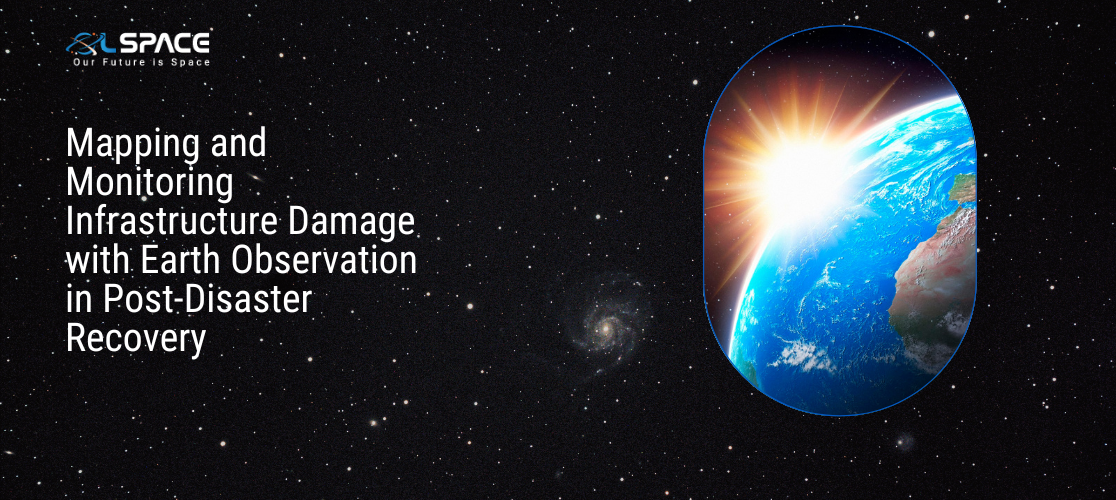23 June 2023
Mapping and Monitoring Infrastructure Damage with Earth Observation in Post-Disaster Recovery

In the aftermath of natural disasters, assessing and monitoring infrastructure damage is crucial for effective post-disaster recovery and reconstruction efforts. Earth observation, through satellite imagery and remote sensing technologies, offers a powerful tool for mapping and monitoring infrastructure damage in disaster-affected areas. In this blog post, we will explore how earth observation can be utilised to accurately assess infrastructure damage, support decision-making processes, and facilitate efficient post-disaster recovery.
Rapid Assessment of Infrastructure Damage: Earth observation provides a rapid and comprehensive means of assessing infrastructure damage after a disaster. Satellite imagery can capture high-resolution images of affected areas, allowing for detailed analysis of damaged buildings, roads, bridges, and other critical infrastructure. By comparing pre-disaster and post-disaster images, experts can identify and quantify the extent of damage, enabling timely response and resource allocation for recovery efforts.
Identification of Critical Areas: Earth observation can help prioritise recovery efforts by identifying critical areas that require immediate attention. By analysing satellite imagery, experts can detect and locate infrastructure damage hotspots, such as collapsed buildings, compromised transportation networks, or disrupted utilities. This information assists emergency response teams and decision-makers in directing resources and manpower to the most affected areas, ensuring a swift and effective response.
Monitoring Recovery Progress: Earth observation enables ongoing monitoring of infrastructure recovery progress over time. By capturing sequential satellite images, it is possible to track and assess the effectiveness of recovery efforts. Regular monitoring helps identify areas where additional intervention may be required, measure the pace of reconstruction, and evaluate the impact of recovery initiatives. This information aids in adjusting strategies and allocating resources based on real-time data, enhancing the overall efficiency of post-disaster recovery.
Geospatial Analysis for Decision Support: Earth observation data, when combined with geospatial analysis, offers valuable insights for decision-making in post-disaster recovery. Geospatial tools can overlay infrastructure damage information with demographic, environmental, and socio-economic data, enabling a holistic understanding of the impact and implications of the disaster. Decision-makers can use this information to prioritise recovery projects, allocate resources efficiently, and develop long-term strategies for rebuilding resilient infrastructure.
Risk Assessment and Mitigation: Earth observation supports proactive risk assessment and mitigation measures in post-disaster recovery. By analysing satellite imagery, experts can identify vulnerable areas, assess potential risks, and develop mitigation plans to minimise future damage. This includes identifying areas prone to landslides, floods, or other hasards and implementing measures to enhance infrastructure resilience. Earth observation data also assists in monitoring and evaluating the effectiveness of risk reduction measures over time.
Collaboration and Information Sharing: Earth observation promotes collaboration and information sharing among stakeholders involved in post-disaster recovery. Satellite imagery and remote sensing data can be easily shared and accessed by various organisations, including government agencies, NGOs, and international aid groups. This shared information facilitates coordination, enables data-driven decision-making, and fosters a more effective and unified approach to post-disaster recovery efforts.
Conclusion: Earth observation plays a vital role in mapping and monitoring infrastructure damage during post-disaster recovery. By leveraging satellite imagery and remote sensing technologies, experts can rapidly assess damage, identify critical areas, monitor recovery progress, support decision-making, assess risks, and facilitate collaboration among stakeholders. The integration of earth observation into post-disaster recovery processes enhances efficiency, improves resource allocation, and enables the development of resilient infrastructure systems. With its ability to provide accurate and up-to-date information, earth observation empowers decision-makers and aids in the effective reconstruction and recovery of infrastructure in disaster-affected regions.
Join our community and never miss an update! Subscribe to our newsletter and blog to stay up-to-date on the latest trends, tips, and insights in your area of interest. Don’t miss out on exclusive content and promotions. Sign up now and be a part of our growing community!
